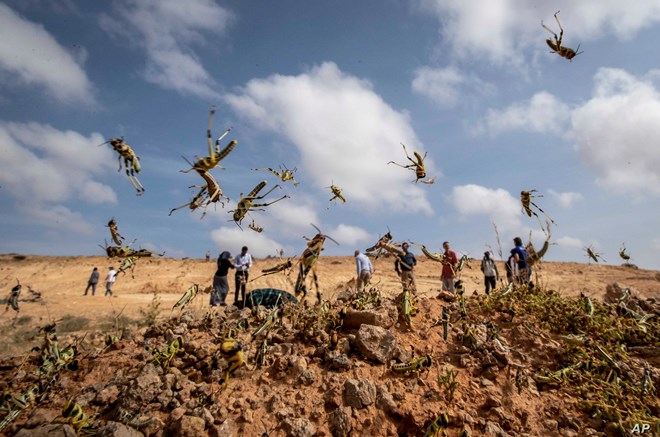
By George Mtimba
Sunday April 26, 2020

FILE - Young desert locusts that have not yet grown wings jump in the air as they are approached by a visiting FAO delegation, in the desert near Garowe, in the Puntland region of Somalia, Feb. 5, 2020.
A second wave of locusts is expected to cause severe damage in Eastern Africa, two months after a group of dangerous pests invaded the region shortly before the outbreak of the coronavirus. ”It seems that those who escaped COVID-19 will face locusts,” said Akinwumi Adesina, President of the African Development Bank and former Nigerian Agriculture Minister.
The last thing Africa needs now is food insecurity. Locusts have already invaded Somalia, Ethiopia, Kenya, Uganda, Ethiopia, and South Sudan. This first wave was in January and February. ”The last time Kenya was affected by a locust invasion of this kind was 70 years ago when it came under British colonial rule,” said Keith Cressman, a locust forensic expert at the UN Food and Agriculture Organization (FAO).
The invasion threatens to cause a food crisis that has already been anticipated in the Horn of Africa, whereby 40% of the 160 million people in this area do not receive proper nutrition, according to the FAO. Despite the existence of strict transport conditions to counter the coronavirus, international experts are already preparing to support efforts to combat the pests through aerial and ground spraying strategies. ‘
“Lack of experience and equipment has hampered efforts to exterminate this pest earlier this year,” Cressman said, giving the pests the ability to lay eggs in the sand and reproduce. Mr. Cressman said that this wave would cause great damage, not only because of their numbers but the insects were starting to eat the plants at the beginning of the growing season. ”Farmers will postpone planting or the locusts will eat the seeds planted in the ground”, he said. ”An issue that is dangerous.”
Large groups of locusts can be up to one kilometer in size. The FAO has succeeded in raising approximately $120 million to address the problem, a move that will support government efforts in affected nations.
”The first group of pests arrived when the farmers were nearing the end of the harvest,” said Cyril Ferrand, the Head of Office of the Food and Agriculture Organization of the United Nations (FAO) in the West Bank and Gaza Strip. Thus there was little damage to the plants. ”However, from the beginning of the rainy season, the new plants meant that the second wave was already doing damage to the plants starting to grow,” he said. ”The desert locusts eat everything green but the plants that grow are their favorite food. And they eat everything.”
Locusts travel by wind. They are expected to reach north in the Sudanese country in June and July, and later into the Sahel region. The United Nations uses various methods to deal with locusts. Although access to adequate food will be affected, climate change triggers the emergence of this condition. One of the functions of UNEP is to disseminate accessible scientific information on climate and its processes to facilitate the formulation of integrated policy and to ensure that relevant sectors take steps to facilitate resilience.
Although traditional chemicals have been used to control locusts, the effects of these chemicals on the environment and on other major ecological systems that facilitate the availability of sufficient food— such as bees and other insects, which in addition to polluting 70 percent of food also affect public health— are an issue irresistible. The task of the World Food Organization is to list any potential harms by using various chemical agents to enable governments to invest in harmless products.
One of the functions of the Food and Agriculture Organization is to provide general information on the invasion of locusts and to give advance warnings and to predict possible invasion. The agency provides information on locusts in desert areas. Also, enabling communities to acquire technology that has many benefits such as solar-powered drywall— which is also an environmentally friendly step— helps them to maintain their productivity.